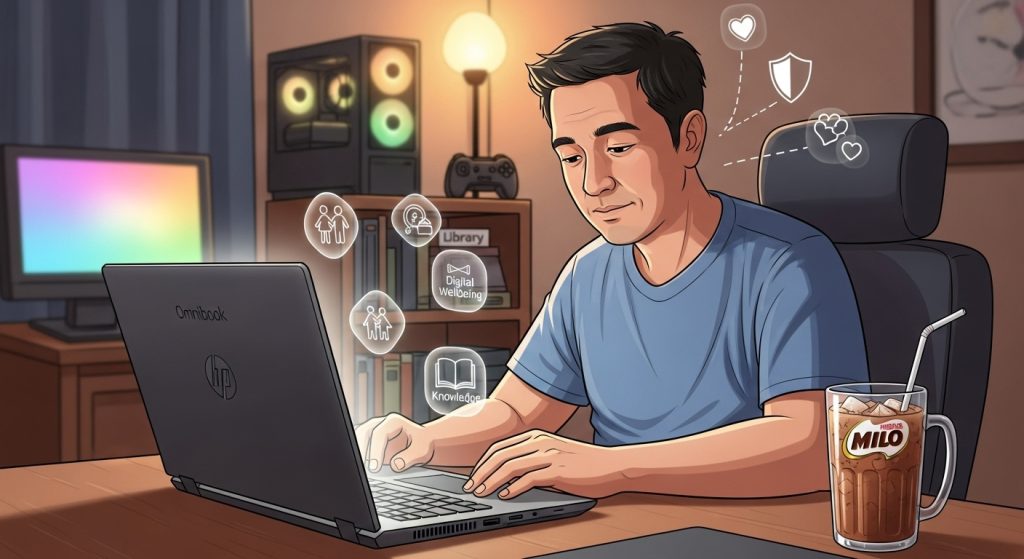Parenting in the digital age is a unique challenge. Our teenagers live in a world where information, connection, entertainment, and risks all travel through the same screen. As an information professional, or as someone who has spent years curating trusted sources, filtering noise, and teaching users how to navigate information safely, I believe that many of the principles we apply in libraries are exactly what parents need at home today.

Why Digital Parenting Matters
The Internet is a double-edged sword. It offers endless learning, creativity, and connection and many other of good stuff… However, it also exposes our children to misinformation, cyberbullying, inappropriate content, and addictive platforms. As guardians of their growth, we must equip them not just with filters but with frameworks for thinking critically and acting responsibly.
Digital parenting is not about policing every click. It is about guiding, mentoring, and empowering teenagers to become responsible “Netizens”. Here are simple, practical ways families can borrow the principles of librarianship to keep teens safe online.
Act 1: Build a Safe Digital Environment
Saudara semua… This is the 1st line of defence. You will need to ensure that you protect the fort at all costs by:
Install parental control on all devices to monitor and control their activities. Tools like Microsoft Family Safety for Windows and Xbox, Google Family Link for Android devices and Apple Screen Time for iOS can set screen time, filter content and produce a report of their activities.
| Tool | Best Use Case | Platform | Key Features |
| Microsoft Family Safety | Microsoft EcoSystem | Windows, Xbox and Android Devices | Screen time limits, content filters, location sharing |
| Google Family Link | Android Users below 17 | Android and ChromeOS | App approvals, screen time, bedtime schedules |
| Apple Screen Time | Apple EcoSystem | iOS, macOS and iPadOS | App limits, downtime, content restrictions |
Then we can secure our home network with DNS filters like the ones below to block harmful sites or adult content at the router level
| Service | Best For | Setup | Features |
|---|---|---|---|
| CleanBrowsing | Families with young kids or teens | Router or device-level | Blocks adult content, phishing, and malware |
| OpenDNS Family Shield | Quick plug-and-play filtering | Router or device-level | Pre-configured to block adult content |
| Cloudflare Family (1.1.1.3) | Privacy-focused families | Router or device-level | Blocks malware and adult content, fast DNS speeds |
Act 2: Teach Digital Literacy, Not Just Rules
This step is about telling them to question everything so as not to blatantly accept whatever is written on the net. As a librarian, I have seen how powerful it is when young people learn to question what they see online. I always tell my kids that not everything online is true. They should learn to pause before believing, sharing, or reacting. Imagine if everyone did this. Just tell them to:
- Evaluate sources. Who wrote this? Why? Is this credible? Is this true?
- Spot manipulation. Clickbait, ragebait. Teach them to recognise emotional triggers and purposeful misinformation tactics by idiots.
- And lastly, you will be defined by your social post. Tell them about digital footprints. Whatever is posted on the net shall become their identity.
- And yes, not to forget. Tell them about oversharing. Not everything is ok to be shared. Again, once posted it will be there forever.
Act 3: Model Good Digital Behaviour
Bapak borek anaknya rintik. They learn from us and they observe more than they listen. If we role-model ourselves by scrolling responsibly, fact-checking news, avoiding toxic comment sections, putting the phone down during meals, and staying away from explicit materials… they are more likely to follow.
I think that digital parenting starts with digital self-awareness.
And, I also firmly believe that totalitarianism does not promote growth and intellectuality. Apart from instilling control and limitations, there must be room for discussion. Rules without relationships breed rebellion. Instead of just saying “No!” say “Let’s discuss.”
Tell why some of the applications or games are off-limits. There must be reasons why Roblox is out but Minecraft is open. Why screen-time is off at 8.30 PM. Ini semua ada jawabnya wahai anak2ku.
Act 4: Self-Space Protection
We have protected our fort, but we must also make sure that they play their role as well. A castle is only as mighty as those who guard it. No point in having the strongest, the strictest firewall if the user is the weakest link. Help them learn to:
- Use strong passwords
- Enable 2FA
- Understand phishing tricks
- Keep personal info private
- Report harmful behaviour
Digital resilience is a skill they will carry into adulthood.
Final Thoughts: From Control to Collaboration
Digital parenting is not about surveillance or control, but it is about stewardship. This is about guiding our teens through the digital wilderness with wisdom, empathy, and shared curiosity. As a librarian, I have always believed in access with responsibility. As father… or better as parent, I extend that belief into my home.
Let us raise a generation that’s not just tech-savvy, but ethically grounded, critically minded, and compassionately connected.